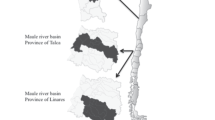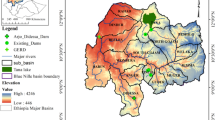Abstract
Improving irrigation management is of relevant importance to ensure a sustainable use of resources in water-scarce areas. Among the actors involved in water management, irrigation communities (ICs) are key players. This work aims to identify which ICs attributes explain the observed variability in performance indicators (PI). To this end, panel data regression models have been applied using a 9-year data set of different indicators from five ICs in the Segura River Basin, south-east Spain. Our study indicates that a limited number of IC attributes—amount of supplied water, water delivery infrastructure, use of groundwater, water allocation method, size and price paid for energy of the IC—explain most of the variability of the PI considered in the study. From this PI approach, it appears that the evaluated ICs should preferably use an on-demand water allocation method, adopt size growing policies and collective action for energy purchase to obtain economies of scale and higher security in water provision to farms, and also to update irrigation systems. Furthermore, water distribution systems that require high energy demand should be used only when they permit to reduce irregularity and risks of shortage in water supply.


Similar content being viewed by others
Notes
Irrigation Communities, Irrigation Schemes, Irrigation Districts, Irrigation Associations or Water User Associations are terms generally employed to define the collective use of irrigation water.
The technology used in the area is based on a pressurised pipe network with individual water meter.
According with the work of Alcon et al. (2014) in the SRB, the adoption of policies to reduce supply uncertainty, such as inter basin water transferences or the use of alternative water resources seem the measures viewed by the farmers with less aversion.
References
Abadía R, Rocamora MC, Córcoles JI, Ruiz-Canales A, Martinez-Romero A, Moreno MA (2010) Comparative analysis of energy efficiency in water users associations. Span J Agric Res 8:134–142
Alcon F, Tapsuwan S, Brouwer R, de Miguel MD (2014) Adoption of irrigation water policies to guarantee water supply: a choice experiment. Environ Sci Policy 44:226–236
Allen RG, Pereira LS, Raes D, Smith M (1998) Crop evapotranspiration- guidelines for computing crop water requirements. Irrig and Drain, vol 56. FAO, Rome
Arcas N, Alcón F, López E, García R, Cabrera A (2010) Análisis del sector agrícola de la Región de Murcia. Año 2009, Informes y Monografías 24. Fundación Cajamar, Almería
Berbel J, Mesa-Jurado MA, Pistón JM (2011) Value of irrigation water in Guadalquivir Basin (Spain) by residual value method. Water Resour Manag 25:1565–1579
Borgia C, García-Bolaños M, Li T, Gómez-Macpherson H, Comas J, Connor D, Mateos L (2013) Benchmarking for performance assessment of small and large irrigation schemes along the Senegal Valley in Mauritania. Agric Water Manag 121:19–26
CARM (2012) Anuario estadístico de la Región de Murcia Consejería de Economía y Hacienda Comunidad Autónoma de la Región de Murcia. Murcia, Spain
CHS (2013) Confederación Hidrográfica del Segura. Segura Basin water agency. http://www.chseguraes. Accessed June 2012 (in Spanish)
Córcoles JI, de Juan JA, Ortega JF, Tarjuelo JM, Moreno MA (2010) Management evaluation of water users associations using benchmarking techniques. Agr Water Manag 98:1–11
European Environmental Agency (2009) Water resources across Europe-confronting water scarcity and drought. EEA Report No 2/2009. Schultz Grafisk, Denmark
Fernández MD, González AM, Carreño J, Pérez C, Bonachela S (2007) Analysis of on-farm irrigation performance in mediterranean greenhouses. Agric Water Manag 89:251–260
García-Vila M, Lorite IJ, Soriano MA, Fereres E (2008) Management trends and responses to water scarcity in an irrigation scheme of southern Spain. Agric Water Manag 95:458–468
Hausman JA (1978) Specification tests in econometrics. Econometrica 46(6):1251–1271
Hill R, Griffiths W, Judge G (2001) Undergraduate econometrics, 2nd edn. Wiley, New York
Malano H, Burton M (2001) Guidelines for benchmarking performance in the irrigation and drainage sector IPTRID. FAO, Rome
Malano H, Burton M, Makin I (2004) Benchmarking performance in the irrigation and drainage sector: a tool for change. Irrig Drain 53:119–133
Melián-Navarro A, Molina-Martínez JM, Rodríguez-Díaz JA, Ruiz-Canales A (2016) Performance indicators to assess the implementation of automation in golf courses located in Southeast Spain. Agric Water Manag. doi:10.1016/j.agwat.2016.11.017
Mesa-Jurado MA, Berbel J, Orgaz F (2010) Estimating marginal value of water for irrigated olive grove with the production function method Spanish. J Agric Res 8(S2):197–206
Montoro A, López-Fuster P, Fereres E (2011) Improving on-farm water management through an irrigation scheduling service. Irrig Sci 29:311–319
Park HM (2009) Linear regression models for panel data using SAS, Stata, LIMDEP, and SPSS Working Paper. The University Information Technology Services (UITS) Center for Statistical and Mathematical Computing Indiana University. http://www.indianaedu/~statmath/stat/all/panel
Perry C, Steduto P, Allen RG, Burt CM (2009) Increasing productivity in irrigated agriculture: agronomic constraints and hydrological realities. Agric Water Manag 96:1517–1524
Rodríguez-Díaz JA, Camacho E, López R (2004) Applying benchmarking and data envelopment analysis (DEA) techniques to irrigation districts in Spain. Irrig Drain 53:135–143
Rodríguez-Díaz JA, Camacho E, López R, Pérez L (2005) Los indicadores de gestión y las técnicas de benchmarking aplicados a la mejora de las comunidades de regantes. Ingeniería del Agua 12(1):63–76
Rodríguez-Díaz JA, Camacho E, López R, Pérez L (2008) Benchmarking and multivariate data analysis techniques for improving the efficiency of irrigation districts: an application in Spain. Agric Syst 96:250–259
Rodríguez-Díaz JA, López Luque R, Carrillo Cobo MT, Montesinos P, Camacho Poyato E (2009) Exploring energy saving scenarios for on-demand pressurised irrigation networks. Biosyst Eng 104:552–561
Salvador R, Martínez-Cob A, Cavero J, Playan E (2011) Seasonal on farm irrigation performance in the Ebro Basin (Spain): crops and irrigation systems. Agric Water Manag 98:577–587
Soto-García M, Martínez-Alvarez V, García-Bastida PA, Alcon F, Martin-Gorriz B (2013a) Effect of water scarcity and modernisation on the performance of irrigation districts in south-eastern Spain. Agric Water Manag 124:11–19
Soto-García M, Martin-Gorriz B, García-Bastida PA, Alcon F, Martínez-Alvarez V (2013b) Energy consumption for crop irrigation in a semiarid climate (south-eastern Spain). Energy 55:1084–1093
StataCorp (2009) Stata: Release 10, statistical software. StataCorp LP, College Station
Acknowledgements
This work was carried out under the GEAMED project “Gestión y Eficiencia del Uso Sostenible del Agua de Riego en la Cuenca Mediterránea” (AGL2010-22221-C02-01), financed by the Spanish Ministry of Education and Science and the ERDF, and the European F7 project “Sustainable use of irrigation water in the Mediterranean Region” (SIRRIMED-FP7-FOOD-CT-2009-245159), financed by DG Research of the European Commission.
Author information
Authors and Affiliations
Corresponding author
Additional information
Communicated by E. Fereres.
Rights and permissions
About this article
Cite this article
Alcon, F., García-Bastida, P.A., Soto-García, M. et al. Explaining the performance of irrigation communities in a water-scarce region. Irrig Sci 35, 193–203 (2017). https://doi.org/10.1007/s00271-016-0531-7
Received:
Accepted:
Published:
Issue Date:
DOI: https://doi.org/10.1007/s00271-016-0531-7




